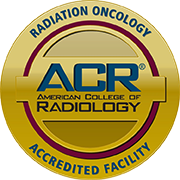Radiation Oncology
The Oregon Clinic offers external and internal radiation for the treatment of cancer.
- ABOUT US
- OUR TEAM
- CONDITIONS & RESOURCES
- FREQUENTLY ASKED QUESTIONS
- OUR LOCATIONS

The Oregon Clinic Radiation Oncology offers a team-oriented approach combined with the latest technological advances to provide the most effective treatment plan available to patients with cancer. We work closely with surgeons, medical oncologists, and primary care physicians to help our patients understand their disease and support them throughout their treatment.
We do our utmost to create an atmosphere that communicates this spirit to our patients and their families.
Radiation Oncology is the use of high-energy rays to stop cancer cells from growing and dividing. Like surgery, radiation oncology is a local treatment. It affects cancer cells only in the treated area. Radiation can come from a machine (external radiation) or can come from an implant (a small container of radioactive material) placed directly into or near the tumor (internal radiation or brachytherapy). Some patients receive both kinds of radiation therapy.
The Oregon Clinic Radiation Oncology offers a comprehensive approach to cancer care with a wide range of world-class cancer therapy modalities implemented by a multidisciplinary team of experts. Our extraordinary team, coupled with state-of-the-art technology, creates the environment for superior treatment outcomes for cancer patients. Our physicians and staff are dedicated to delivering compassionate care for our patients while offering support to their families; patient-centered care is our philosophy.
- Dr. Steven Seung is announced as a Newsweek Top Cancer Doctor for 2015
- Dr. Kristina Young Receives ASCO Young Investigator Award. The title of her research grant is “Targeting the Tumor Stroma to Enhance Radiation Efficacy”.
- Radiation Oncology Facilities Served by The Oregon Clinic Receive ACR Accreditation
Refer a Patient
For referrals from a hospital location, please be aware that we are not set up to accept referrals electronically through EPIC at this time. Please call us directly for immediate and personalized service.
 CONDITIONS
CONDITIONS
- Benign and malignant tumors
- Brain Cancer
- Breast cancer
- Gastrointestinal cancer
- Gynecologic cancer
- Head and neck cancer
- Lung cancer
- Lymphoma
- Melanoma
- Prostate cancer
- Sarcoma
- Soft tissue cancers
 Procedures & Treatments
Procedures & Treatments
- Accelerated partial breast irradiation (APBI)
- Deep inspiration breath hold (DIBH) technique for breast cancer treatment
- HDR brachytherapy
- Image-guided radiation therapy (IGRT)
- Immunotherapy
- Intensity modulated radiation therapy (IMRT)
- Intraoperative radiation therapy (IORT)
- Iodine-125 eyeplaque treatment for ocular melanoma
- Respiratory motion management (4DCT)
- Stereotactic body radiation therapy (SBRT)
- Total body irradiation (TBI)
- Total skin electron radiotherapy
- Gamma knife stereotactic radiosurgery
- ViewRay MRIdian MR Linac radiation therapy
Below you will find answers to common patient questions, answered by our board-certified team of radiation oncologists.
No. Within a millisecond of the machine being turned off there is no residual radiation in your body. Therefore, there is no cause for concern about radioactivity inside of you or exposing your friends or family to radiation during your course of treatment.
In general, no. If you are being treated with brachytherapy (radiation source placed inside of the body) or with the Gamma Knife (stereotactic radiosurgery), radioactive substances are used for these procedures. For all other radiation treatments, we produce our own radiation which stops as soon as the machine is turned off at the end of your treatment session.
Iridium-192 is an isotope of Iridium which has a ½ life of 74 days. For treatment, the source is deployed from a small machine about the size of a college dorm refrigerator. Iridium-192 emits gamma rays with an average energy of 380KeV, which results in limited penetration in the body away from the treated area. Most brachytherapy treatments with Iridium-192 are used for breast, uterine, and cervical cancer in our departments.
Our treatment machines are linear accelerators which use a lot of electricity to accelerate electrons and aim them into a target made of a heavy metal (Tungsten). The interaction of electrons with a large atom such as Tungsten produces gamma rays which are precisely aimed for treatment to the area of interest.
No. Although the table on the machine may be hard and uncomfortable to lie on for prolonged periods, radiation treatments do not cause pain. If you experience pain during treatment, the radiation can be stopped so that the medical team can evaluate the situation and make adjustments if necessary.
You will be in our department for approximately 30 minutes on a daily basis (Monday-Friday). You will be lying on the table on the treatment machine for about 15 minutes and the machine will be delivering radiation for about 2-3 minutes. Some types of treatment may take longer, but most radiation treatments are scheduled in 12-15 minute time slots.
Yes, tumor cells do not behave based on what the time is. It turns out that studies have shown that the human body can tolerate more radiation if there is no treatment given for a couple of days every week. This is because of the body’s normal cells ability to repair the damage to DNA from ionizing radiation in as little as six hours after exposure.
It turns out that our body’s normal cells have a good mechanism for radiation repair from exposure from ultraviolet radiation from space and ionizing radiation from the earth. Most cancer cells are putting all of their energy into cell division and are generally not good at repairing damage to DNA from radiation. Therefore, radiation preferentially affects cancer cells instead of the body’s normal cells.
Your radiation treatments will be given under your radiation oncologist’s supervision by radiation therapists. Radiation therapists are trained professionals who are licensed by the state to deliver radiation therapy safely and accurately. It is actually not legal for your doctor to operate the radiation machine to deliver your treatment.
The radiation therapists will monitor you by closed-circuit camera with audio during the duration of your treatment (typically less than five minutes). Treatment can be interrupted if needed and the therapists will inform you of how to let them know that you need their attention. The therapists cannot be in the room with you during treatment because of the risk of radiation exposure.
No. The type of radiation produced by our linear accelerators is powerful enough to penetrate lead up to an inch or two thick. Wearing a lead apron would not protect you and would slightly increase the dose received by the skin in the treatment area. The risk of developing a cancer related to radiation therapy is typically very low (well under 1%) for most patients.
Nearly all treatments are delivered five days a week (Monday-Friday). There are some situations where treatment is not delivered on a daily basis, but this is not common. Typical treatment courses last between two and eight weeks, however some situations may require as few as one treatment. Your doctor will provide you with information regarding the best treatment schedule based on your specific situation.
Simulation is an important process where your radiation treatment position will be established and images of your body will be obtained for treatment planning. Most patients have a CT scan (low radiation dose protocol, no contrast in the bloodstream in most cases) performed in our department as part of this process. The information from the simulation process is used to create a unique three-dimensional treatment plan based on your specific anatomy and treatment location. Small tattoos are placed on the skin at this time to ensure reproducible and accurate positioning on a daily basis for radiation treatment.
Most patients have a CT before starting radiation treatments as part of the simulation procedure. The scan utilizes a low radiation dose protocol and often does not involve contrast in the bloodstream. Another scan is obtained as the body’s position for radiation treatment is different than the position for diagnostic scans. Also, the radiation oncologist is present during this procedure to assist with your positioning and any other procedures necessary for planning your course of radiation.
In most cases, you do not need to have routine blood work during radiation therapy. Radiation can inhibit bone marrow function (mostly located in the spine and pelvis in adults) which may reduce the number of red cells, white cells, and platelets in cases where a moderate amount of bone marrow is in the radiation fields. Your radiation oncologist will help you monitor your blood counts if needed.
The side effects of radiation depend on the treatment site. In most cases, the side effects will be limited to the area of the body receiving treatment. Most patients can expect mild to moderate fatigue which resolves within 4-6 weeks of completing treatment. Skin reaction consists of redness, itching, and dry peeling in many cases with the chance of a radiation burn (blistering or moist peeling of the skin) of less than 15% in most cases. Your doctor will describe expected side effects in your case based on your treatment type and area of the body receiving radiation treatments.
You will meet with the radiation oncologist at least once per week during treatment. This usually consists of a short visit immediately after your treatment on a weekly basis and does not require a separate appointment. Although not required by law, our policy is that a physician is in the department whenever radiation therapy treatments are delivered. Your doctor or one of his/her partners is available to see you on any day during the week; just let our staff know if you have any questions or concerns.
In most cases, there is not an interaction between most drugs or supplements and radiation therapy. Chemotherapy agents are an important exception, and your radiation oncologist will work closely with your chemotherapy doctor in cases where chemotherapy and radiation are given at the same time. Your doctor will need to have a complete list of all of your medications and supplements so you can be informed of any potential interactions. If you start or stop a medication or supplement during treatment, please let your radiation oncologist or nurse know so that we can keep your medication record up to date and provide you with advice if needed.
Most radiation treatments are delivered in less than five minutes once you are set up in the exact treatment position. You are monitored (audio and visual) during treatment and the radiation treatments are designed to take into account normal breathing and swallowing during this time. If you are having pain or difficulty during treatment, the therapists will be able to recognize this and interrupt your treatment to provide assistance if needed.
Cone beam CT is a type of image guidance where the radiation machine will spin around you one to two times before your treatment is delivered. Images (similar to CT images) are produced and reviewed by your doctor at the control panel just before treatment is delivered. This allows for fine tuning of the aim of the radiation beams for your treatment on a daily basis by the physician and results in more accurate delivery when additional precision is necessary in some treatment cases (typically used for head and neck and prostate cancer treatment).
Radiation therapy works by causing mutations in the cell’s DNA. Fortunately, our normal cells are quite good at repairing damage to DNA while cancer cells are not good at this process. Treated cancer cells do not die immediately; the damage to their DNA causes the cell to die the next time it tries to divide. Therefore, it can be several weeks between treatment and when a response would be expected. If your physician is concerned about growth of disease or other symptoms, he/she will obtain imaging (if indicated) at that time to help to determine the best course of treatment or intervention.
There is excellent, comprehensive, easy to understand information available from The American Cancer Society (www.cancer.org), The National Cancer Institute (www.cancer.gov), and The American Society of Clinical Oncology (www.cancer.net). Detailed information and videos about radiation therapy can be found from the American Society for Radiation Oncology (www.rtanswers.org). Your radiation oncologist can be helpful with any questions or by helping you research specific topics as well.










